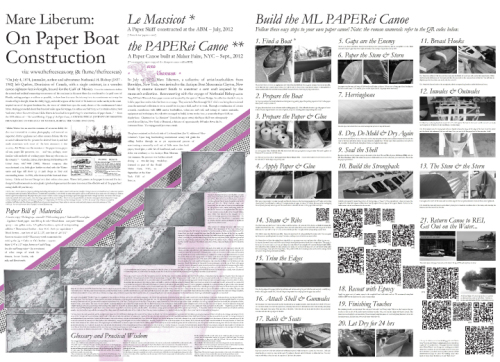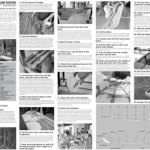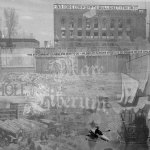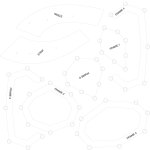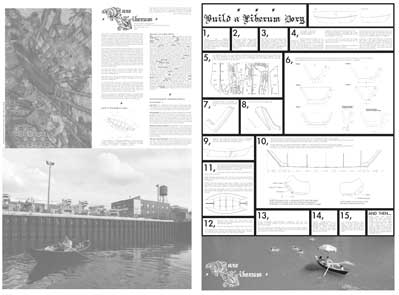Of Liberum Dories, Kayaks and Paper Boats…
Paper Boats (2012-)
At long last we have completed work on our three year long investigation into the histories and techniques of paper boat building, originating with the Waters & Co. paper boat and dome factory in Troy New York (mid to late 19th century) to the more recent artistic excursions on the water in… things made of paper. The attached broadsheet details the first phase of our research. Click the image above to download the 3.9mb pdf and happy boating!
Post any comments or questions below, on our facebook page – http://fb.me/thefreeseas and thanks for reading.
The Liberum Kayaks (2010-2012):
(image from the Can Factory, courtesy Susannah Tantemsapya - thanks Susannah!)
Mare Liberum, Liberum Kayak Broadsheet – prints to 22.5″ x 30″
Liberum Dories (2007-2011):
Then download these stencils:
new_ml_stencils
They can be printed “tiling” on any laser printer, outputted to an oversize digital printer, or to a laser cutter, or what have you.
These instructions (with those in the broadsheet) detail just one method for building a boat – it is one we have tried and tested and have found to balance skill level with easy to find tools and materials and proven practices. You may still need to experiment with shapes, tools and materials depending on what you have available, the time you want to spend building, skill level, etc. Small scale boat building will always be an intuitive art, requiring careful study of how the materials behave together. Our intention was to make a boat out of readily available materials, which here in New York City include scrap plywood, 2×4’s, construction adhesive, deck screws, cast-off moulding for a decorative finish, etc. These are the staples of the development-happy urban or suburban environment. Obviously, the design can and should be modified as much as possible to factor in the most easy-to-come-by materials in any given area. (One version of the boat we toyed with was a dory skinned entirely out of hot-pressed plastic bags.) The boat we’re currently working on uses fiberglass tape and epoxy to seal its seams. We’ve also experimented some with pine tar and cloth as a sort of ‘oakum’ seal between the boards. In thinking about these things, it was most important for us to think about safety (ie, will the boat come apart in water?) and at the same time, we are not expecting these first forays to withstand forty years of service in salt water. These were our limitations and expectations. Know your own.
Before you begin:
Contact us and order the stencils (or download the .dxf/.ai files above and output your own stencils on a CNC router/plasma cutter or print ’tiling’ and reassemble from 8.5×11 paper). Traditional boat building relies on series of charts, blueprints, and ‘tables of offsets’ to derive the intended shape of the boat. We simplified this process somewhat by designing dressmaker-like patterns which can be stenciled on to your available materials (5 4×8 sheets of plywood, for example). You will then cut along the lines and in the end you’ll have most of the parts you need to stitch your boat together. Check the ‘parts list’ below to make sure you have made all of the necessary cuts.
There are still a few pieces you will need to hand-assemble based on instruction #6 in the broadsheet. These are the ‘frames,’ the ribs or bones of the boat. They can be built out of anything you have on hand. We used 1×3’s, 2×4’s or cut out the pieces from thick plywood (1inch). In the end, 1×3’s provided the easiest option.
Parts list:
(1 pc) Bottom board (made from 2 4×8 pieces of plywood, joined in the middle using the ‘bottom block’ piece)
(2 pcs) Side pieces (made from 2 pieces each, joined in the middle using ‘plank block’ pieces)
(1 pc) Transom (cut from a single piece of 3/4″ or thicker plywood)
(2 pcs) Plank blocks (one for each side piece)
(1 pc) Bottom block (used to screw down into bottom board halves)
(1 pc) Stem / bow stem (sandwich and screw together 2 inner stem pieces inside 2 outer stem pieces)
(1 pc) Stern knee (sandwich and screw together 4 stern knee pieces)
Gunwales (as desired – they add strength and stability to the plywood sides and give you something to lean on/not cut your hands on, however, on our last boat we passed on gunwales and added round moulding around the top edges instead.)
Recommended equipment:
A jig saw
Screw guns
Sawhorses
Wood clamps
Hand planer
Rough order of operations:
Paint stencil parts onto wood materials.
Cut shapes out of plywood / build ‘frames’ following instructions in broadsheet
Glue and screw together stern knee, bow stem
Glue and screw together bottom board halves using bottom block piece
Glue and screw together side pieces using plank blocks
Attach transom frame and stern knee to transom
Once the bottom board is stable and joined, place it on a pair of sawhorses.
Begin clamping, then screwing ‘frames’ into place when proper placement is found. Measurements can be derived from broadsheet, or follow guides on bottom board stencils.
Clamp transom to bottom board
Clamp stem to bottom board
Begin clamping sides to frames. Add construction adhesive or wood glue between joints and screw together once sides are in proper place.
Reinforce the seam of the bottom board with the side joints using construction adhesive and ‘chine blocks’. Chine blocks are square blocks with one angle which matches the angle of the side piece at the bottom board. They can be cut out of 2×4’s and place in the bottom of the boat wherever needed (one placed midway between each frame would seem a good idea).
You now have a boat (more or less).
Plane or sand down any rough edges or those that do not meet up to your satisfaction. Add gunwales or moulding. Add a raised floor which spans the frames and will keep you from walking on the bottom board directly.
Think about sealing your boat. In practical terms, many modern boats are built from plywood and covered in fiberglass and epoxy. If you wish to keep the plywood exposed, experiment! And always test your boat in shallow water.
When your boat is built, check out our page on the Mare Liberum naming convention – the link’s on the sidebar to the left.
Drop us an e-mail if you have questions or need help: littleboats [at spam anti spam] thefreeseas.org.

